
Westborough and the surrounding area offer numberous locations with walking trails. The
Westborough Reservoir
is among these and offers a diversity of wildflowers in a relatively small area. Described
here are wildflowers found at other locations in and around Westborough. Many of these are
part of the Westborough Charm Bracelet
project linking 26 miles of local trails. The Charm Bracelet site offers trail maps for many
local conservation areas.
Bloodroot, Poppy family (Papaveraceae), Native

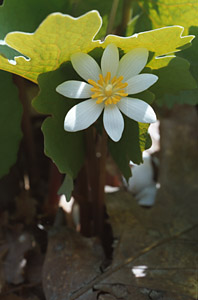
|

Bloodroot owes its name to the acrid reddish sap in its stem and root. Native Americans and colonists used the sap to make a red-orange dye for clothing and baskets. Mixed with animal fat, the sap served as face paint for Native Americans. They also rubbed it on their skin as an insect repellent.
Native Americans had various medicinal uses for bloodroot, such as treating rheumatism with tea made from the root. They also put the sap on a lump of maple sugar and sucked it to alleviate sore throats, a remedy that colonists adopted. In American medicine of the past, the root provided an ingredient for cough syrup. In recent decades, an extract called sanguinarine has been used commercially as a plaque-fighting ingredient in toothpaste and mouthwash.
A member of the poppy family, bloodroot contains some of the same chemicals found in other plants in the
family, including the opium poppy. The root is considered toxic and should not be ingested.
Trout-lily or Dog Tooth Violet, Lily family (Liliaceae), Native

 |
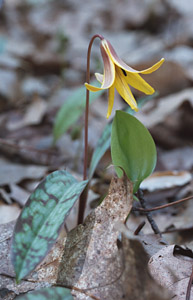 |
 |

The odd name trout-lily may come from the time of year that the plant blooms--early in spring, around trout season. Another explanation is that the name comes from the similarity of the mottled leaves to the pattern on the sides of certain trout. The camouflaging mottled pattern may also be responsible for another name, fawn lily.
The plant has two other unlikely names. One is dog tooth violet. Although the plant is a lily, not a violet, it may have acquired this name because it blooms when violets bloom. The description "dog tooth" may refer to the pointed end of the bulb-like corm from which the plant grows. The second unlikely name is adder's-tongue, which is possibly related to the lance-like shape of its two leaves, suggesting a forked tongue.
Trout-lily grows in dense beds, spreading as the bulb-like corms send down threads that form small new corms several inches underground. Young corms send out leaves and more corm-producing threads, but they do not bloom for several years. The whole network of threads and corms helps to hold the soil together in an area, preventing erosion. Eventually flowers produce seeds, many of which are distributed by ants. The seeds form new corms the following spring.
Young trout-lily leaves have been cooked as greens, and the corms, like the bulbs of many lilies,
have been cooked as a vegetable. Native Americans found medicinal uses for trout-lily, using root
tea for fevers, making poultices for sores and splinters, and even eating uncooked leaves for
contraception. Present-day research indicates that water extracts of the plant act against bacteria.
Birdfoot Violet, Violet family (Violaceae), Native

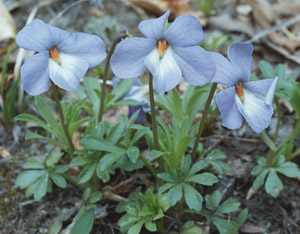
|

Birdfoot violet is capable of blooming a second time in a year, typically in the fall. The plants favor
sunny, dry, sandy locations.
Marsh Blue Violet, Violet family (Violaceae), Native

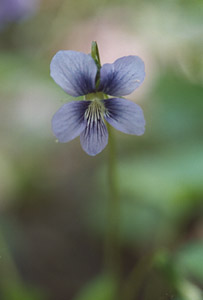
|

Like many but not all violets, marsh violet can actually produce two kinds of blossoms. The first kind is the showy springtime flower that everyone notices, including pollinating insects. The second kind is a smaller, inconspicuous blossom that looks something like a developing bud and typically appears in the summer. This second kind never opens but fertilizes itself and also bears seeds later in the season. It serves as a sort of insurance policy, allowing the violet to produce seeds even when cross-pollination does not take place. Various other kinds of plants besides violets use this insurance policy.
Like other violets, the young leaves have been used in salads, the flowers have been candied, and the
dried leaves used to make tea.
Stargrass, Daffodil or Amaryllis family (Amaryllidaceae), Native

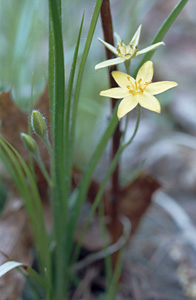
|


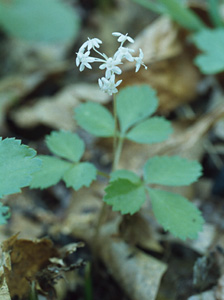
|

Dwarf gingseng is unusual because the plants can produce male flowers one year and female flowers in another year. Possibly because seeds and fruit take a lot of energy to make, the largest plants are usually the ones that produce female flowers. Somewhat smaller plants usually produce male flowers. After bearing its yellowish berries, a plant usually has male flowers the next year. It has been estimated that every year about one fourth to one third of the plants in an area switch from producing one kind of flower to the producing the other.
The tubers have served as food, either raw or cooked. Native Americans made a tea from the plant to treat an assortment of ills. They also chewed the root for headaches and other problems.
Dwarf ginseng is not the same as American ginseng (Panax quinquefolius), a larger plant that has
become scarce due to over-picking. The leaves of American ginseng have five parts instead of three,
like dwarf ginseng. American ginseng has been used as a substitute for yet another
gingseng, Asian gingseng ( Panax gingseng), which has traditionally been widely used in China as
a medicine, a tonic for increasing endurance, and an aphrodisiac.
Rue-Anemone, Buttercup family (Ranunculaceae), Native


|

Native American made a tea from the root to treat diarrhea and vomiting. The root is sometimes
considered edible but may in fact be toxic.
Crown-Vetch, Pea family (Leguminosae), Alien


|


 |
 |
 |

The plants have become widespread as weeds, growing in yards and waste places. They bloom from spring to fall and sometimes serve as ground cover. The reclining stems root from the nodes where leaves grow.
The young leaves and stems of Asiatic dayflower can be used in salads or as cooked greens. The leaf tea has
medicinal uses in China, where it has provided a gargle for sore throats. It has also been used there to
alleviate symptoms of various infections, including flu, tonsillitis, and urinary infections.
Helleborine, Orchid family (Orchidaceae), Alien


|

Blue Vervain, Vervain family (Verbenaceae), Native


|

Most vervains are native to the Americas, but European vervain has long been entwined with people's beliefs. On one hand, vervain had a place in ancient Roman, Druid, Jewish, and Christian religious ceremonies. On the other hand, it was also associated with witchcraft and was supposedly used in witches' brews. Various folk beliefs have involved the use of vervain to bring either good fortune or ill.
Native Americans used vervain tea for various respiratory, digestive, and female problems. Vervain also
had similar uses in European and American folk medicine.
Beechdrops, Broomrape family (Orobanchaceae), Native


|

In the past, people made tea from the fresh plants to treat intestinal problems such as diarrhea, as
well as mouth and cold sores. The plant was also called called cancer root because it was supposed to be effective
against cancer. Unfortunately, modern research has not supported this belief.
"Ants and Plants," USCS Herbarium - Ants and Plants, University of South Carolina Spartanburg, 2001, http://www.uscs.edu/academic/colla&s/herbarium/ants.htm, 2/23/02.
Bernhardt, Peter, The Rose's Kiss: A Natural History of Flowers, Island Press, Washington, D.C., 1999.
Culley, Theresa M., "Why Violets Are So Successful", The Violet Gazette, Autumn 2000, Volume 1, Number 4, p. 4, American Violet Society, 2/23/02.
Culver, David C., and Beattie, Andrew J., "Myrmecochory in Viola: Dynamics of Seed-Ant Interactions in Some West Virginia Species," Journal of Ecology, Volume 66, Issue 1 (Mar., 1978), 53-72.
Dwelley, Marilyn J., Spring Wildflowers of New England, Down East Enterprise, Inc., Camden, Maine, 1973.
Dwelley, Marilyn J., Summer and Fall Wildflowers of New England, Down East Enterprise, Inc., Camden, Maine, 1977.
Foster, Steven, and Duke, James A., A Field Guide to Medicinal Plants and Herbs of Eastern and Central North America, Second Edition, Houghton Mifflin Company, Boston, 2000.
Kricher, John C., and Morrison, Gordon, A Field Guide to Eastern Forests, Houghton Mifflin Company, Boston, 1972.
Newcomb, Lawrence, Newcomb's Wildflower Guide, Little, Brown, & Co., Boston, 1977.
Peterson, Lee Allen,Edible Wild Plants of Eastern and Central North America, Houghton Mifflin Company, Boston, 1977.
Peterson, Roger Tory, and McKenny, Margaret, A Field Guide to Wildflowers of Northeastern and North-Central North America, Houghton Mifflin Company, Boston, 1968.
Sanders, Jack, Hedgemaids and Fairy Candles: the Lives and Lore of North American Wildflowers, Ragged Mountain Press, Camden, Maine, 1993.
Thieret, John W., Niering, William A., and Olmstead, Nancy C., National Audubon Society Field Guide to North American Wildflowers, Revised Edition, Alfred A. Knopf, Inc., New York, 2001.
Weiner, Michael A., Earth Medicine, Earth Food, Ballantine Books, New York, 1980.
New England Wild Flower Society
The North American Native Plant Society
and Wildflower Magazine
Westborough Charm Bracelet
- Project linking 26 miles of local trails. Trail maps online.
| A photo index of this site may be found here. Our main wildflower site is found here 

|  Home /
Contact
Home /
Contact
| |
| Copyright © Anne A. Reid 1999-2002 Photographs copyright © Garry K. Kessler 1999-2002 |
 |
|
|